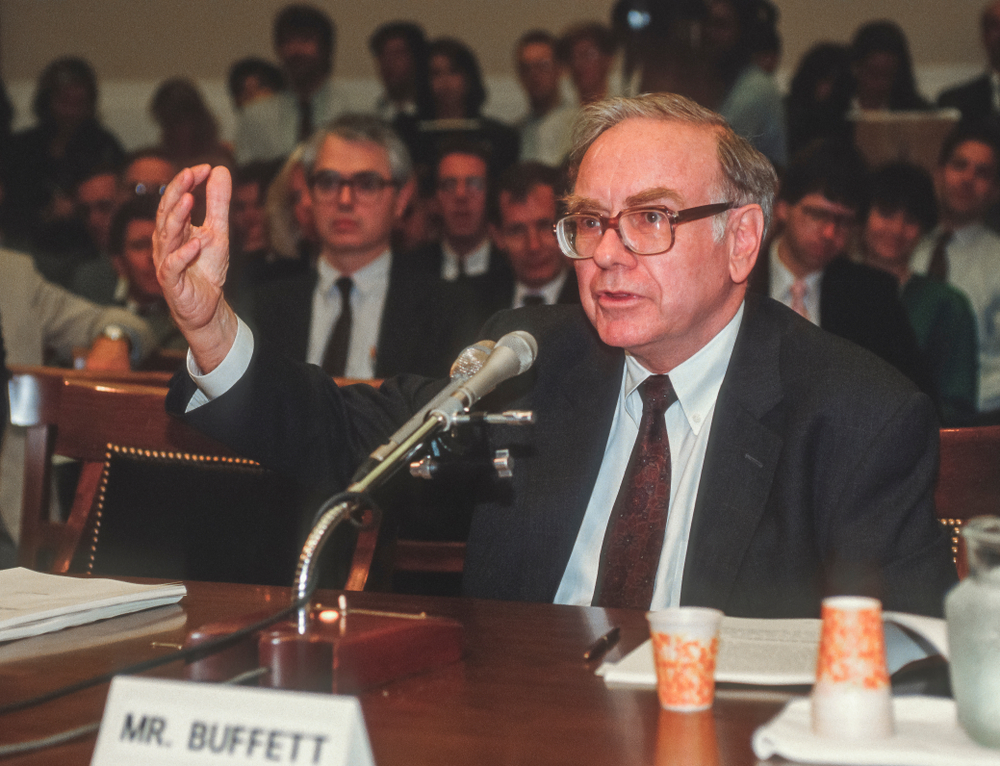I was obsessed with Warren Buffett. So obsessed I wrote a book, my second book, about Warren Buffett. It was called Trade Like Warren Buffett.
I both loved him and hated him. I loved him that he was so correct all the time. So dead on. I hated him because I was jealous of him, but also because I thought ONE TIME he said something that I didn’t like.
After 9/11 he went on CNBC and he said, “There is almost a near 100% chance that there will be a nuclear event on U.S. soil within the next 50 years.”
BOOM!
As someone who lived four blocks from Ground Zero that scared the hell out of me. And scared the hell out of the stock market.
Why did he scare people like that?
Because, among all the other things he owns, he owns an insurance company that covers “catastrophic insurance for events.”
So suddenly the Super Bowl (as an example) would call him and say, “Warren! We want to be insured against a nuclear catastrophe.”
“No problem,” he’d say, “It will cost you $2 million.”
They’d pay.
The Super Bowl would happen each year, no nuclear event, and he’d keep the $2 million and would do almost no work.
Is this investing?
Is this a form of gambling? Is this value investing, Warren Buffett-style?
Yes and yes and yes. Investing is when you have an unfair advantage.
And Buffett’s Not The Only One…
When Peter Lynch bought Hanes in the 70s he knew that his wife Lynn and all her friends were buying the eggshaped “L-eggs” pantyhose.
They RAVED about them. The pantyhose were sold at the checkout counter at the grocery store. All other pantyhose were sold at department stores.
Lynch did the research: women went to grocery stores six times the amount they went to department stores. All the other stocks in the space were ranked by how well their products sold at department stores but Lynch knew that this would change (ultimately every company is valued on profits and revenue growth).
So he loaded up. He had created his own unfair advantage by doing the work to model future sales of L’eggs, the demise of the department store model for selling clothes, and he knew there was a great demand among women.
Then he used his extra resources to have conversations with high up executives at Hanes. Not insider information, but still an unfair advantage.
He made 10 times on his money. Not bad.
This month, I want to explain Buffett’s advantage over the markets in detail. These are all lessons you can take with you as an investor.
Specifically, I’ll discuss:
1. The many ways Buffett has made his money
2. Why Buffett uses an insurance company structure rather than a hedge fund to make the most money from his investing
3. The advantage of piggybacking Buffett versus owning an index fund
4. Buffett’s top 15 holdings
5. The Lindy Effect
After that I’ll discuss a Warren Buffett profit play you can make today…
How Buffett Makes His Money
Let’s look at ways Warren Buffett can (and has) made money in the past. He’s used both personal means and financial institutions to grab his profits.
Investing for Himself
Buffett can easily make 10% per year on his money (and he has). But much better to invest other people’s money on that and take fees.
Mutual Funds
Buffett has never done this.
A mutual fund collects people’s money, takes a small fee (1-4%) and that’s it. It doesn’t make more if it does well or poorly. It has no “skin in the game” as Nassim Taleb would say.
Hedge Funds
Buffett started a hedge fund in the 1950s until 1969.
A hedge fund takes investor money, invests it, and makes money in two ways:
First, through a 2% management fee. If I put $1 million into a hedge fund, the manager of the fund makes $20,000 right way —― 2% of my $1 million every year.
Second, the fund manager makes 20% of the profits.
If I put in $1 million in and the hedge fund is up 20% ($200,000), the fund manager takes another 20% of $200,000 ($40,000).
This is a great way to make money and it’s why so many good investors are billionaires AFTER they start their hedge funds and raise a lot of money (Howard Marks, Ray Dalio, Carl Icahn, George Soros, Jim Simons, etc. etc.).
Banks
Buffett has owned banks.
For a bank to make money, they break even on fees (fees for opening an account, fees for investing, etc.) and costs (ATM machines, branches, tellers, etc.).
BUT they take all the money in your accounts (where you make 0-1% on your savings accounts and 0% on your checking accounts) and they lend it to home buyers for 5%.
So if I put $100,000 into my checking account and the bank lends it to a homebuyer, they make $5,000 a year because of me (5% interest to the home buyer but they give me 0% of that in my checking account).
It’s a great business model — but eventually, I want all of my money back and they have to give it back the second I ask.
Insurance Companies
As I mentioned earlier, Buffett has made money on insurance.
An insurance company is exactly like a hedge fund, with a few important differences:
• I never want my money back if I buy insurance. Reason being, if I’m getting my money back it means I’m sick or that something bad happened. Here’s my money! Keep it!
• The insurance company keeps 100% of the profits it makes on that money — not 20% like in a hedge fund.
• Unlike a bank (the bank also keeps 100% of the profits), I cannot get my money back any time I want to.
For Buffett, Insurance is the Clear Winner
So Buffett shut down his hedge fund and focused on just insurance. He was worth $20 million at the time. But within a decade, he had made his first $1 billion and he went on to make 50 times that over time.
This is why many hedge funds have also set up insurance companies. It’s a much easier way to make money.
They basically take huge bets (like “a nuclear bomb won’t hit the Super Bowl”) where they have a statistical advantage.
This, of course, is also uncorrelated to the stock market and stock market returns. Always think about your unfair advantage.
In insurance, Buffett will model the odds of a nuclear attack on the Super Bowl (basically… 0%). But he knows the owners of the stadium will easily pay $2 million if he creates the fear (talking on CNBC). He will make the owners think there is a > 0% chance (say… 5%) and then charge for that.
In insurance, if you know someone is “probably” going to live to 90 (based on their age, demographics, medical condition, etc.), then you will sell them life insurance at 60. If you think they will live to 72, you might not be able to sell them life insurance at 60. In insurance, you always calculate your risk of loss: how much you lose, how much you think you can make each year on the money used to buy the insurance, and then you offer it to as many people as possible so that statistical outliers won’t hurt you.
For instance, if I’m going to “statistically” live to 70 and I’m 50, maybe Warren Buffett will charge me $1 million to buy $4 million worth of life insurance.
“Always think about your unfair advantage.”
Because he knows that he can make 10% a year on the $1 million for 20 years.
So when I die at 70, he pays $4 million to my beneficiaries — but he’s made $6.2 million on my money ($1 million compounded at 10% for 20 years, which is lower than his average annual return so he is being conservative). He pockets $2.2 million. That’s an unfair advantage (and also why insurance is largely a scam).
The Value of a “Buffett Basket” of Stocks
But Buffett also has an unfair advantage with stocks.
For instance, he can call any CEO in the world and say, “Hey, how’s it going?” And they will tell him.
Who wouldn’t want to talk to Warren Buffett? Nobody! That’s a great advantage.
In fact, some scientists have studied the following question: If you piggyback Warren Buffett’s trades (i.e. buy the same stocks he is buying as shown in his SEC filings), how much better than the stock market will you do?
There have been several papers written about this research. If you’re interested, here is a link to the first.
The answer to this question? 11.4% better than the stock market, on average, every year.
That’s very good. Almost impossible. Which is why Buffett is the best. Given all other things being equal, if someone told you to buy a basket of stocks and you had two choices — a basket of Buffett’s top 20 holdings OR an S&P 500 Vanguard Index fund — do the Buffett basket.
Buffett’s Top 15 Holdings
Here are Buffett’s top 15 holdings. I removed any companies that he sold shares of in the past quarter:
1. Apple (AAPL) — Despite saying he doesn’t invest in technology, this is his largest investment
2. Bank of America (BAC) — He just bought 31 million MORE shares
3. Coca-Cola (KO)
4. Wells Fargo (WFC)
5. American Express (AXP)
6. Kraft Heinz (KHC)
7. U.S. Bancorp (USB)
8. JPMorgan (JPM)
9. Moody’s (MCO)
10. Delta (DAL)
11. Goldman Sachs (GS)
12. Bank of New York Mellon (BK)
13. General Motors (GM)
14. Southwest Airlines (LUV)
15. Verisign (VRSN) — The core servers of the entire internet are owned by VRSN
The core servers of the entire internet are owned by VRSN There are a few interesting things to note here.
First, you’ll notice that a lot of Buffett’s investments are banks. Again, a bank is like a hedge fund but they get to keep 100% of their profits.
Second, these stocks typically trade at a low multiple of earnings.
Some stocks that are very speculative lose money (Uber, Beyond Meat, etc.) or trade at a very high multiple of earnings. But Always think about your unfair advantage.
Buffett says to himself: “I can get 4% buying municipal bonds that are safe. So I need a company that is ‘returning on their market cap’ more than 4%. i.e. if they are worth $100, they make more than $4 in earnings.” Else, he would make the safer investment.
Apple, as an example, has a forward price over earnings ratio of 16. Whereas Dropbox (DBX) — a company Buffett does not own — has a forward price over earnings ratio of 31. Another thing to note is what is called “The Lindy Effect.”
“The Lindy Effect”
Nassim Taleb discusses this statistical phenomenon in his excellent book, Fooled by Randomness. William Poundstone also studies it in his recent book, The Doomsday Equation (where he uses it to forecast the demise of the human race).
The Lindy Effect basically says that if X has been around for Y years, then it will probably be around for Y years more.
Of course, it doesn’t always apply. You can’t take a 100-year-old person and say they will be around another 100 years.
BUT you can put your finger down in the phone book, pick a name, and say, “However old this person is, he/she will probably double that in lifespan.”
Many of Warren Buffett’s holdings are over 100 years old. He is a believer in the Lindy Effect.
He also has a great quote that I love: “If a company has been around 20 years, it’s probably a good investment.”
Note: He doesn’t say ALWAYS. But PROBABLY. Buffett is a statistician at heart more than anything else.
With all of this in mind, it’s time we gain an investing edge like Warren Buffett…
Profit Play: Direct Access to Warren Buffett’s Portfolio
We talk a lot about Warren Buffett for good reason. He exudes unparalleled investment success with a business acumen second-to-none.
I’m of the school of thought: If you can’t beat ‘em, join ‘em. Don’t get me wrong, I’ll try to beat ‘em first, but it doesn’t always work out.
A lot of investors, taking what they know about Buffett, might think it makes the most sense to simply buy shares of his firm, Berkshire Hathaway.
There’s nothing wrong with that approach… assuming you have the $300,000-plus needed to buy a SINGLE share of Berkshire Hathaway’s class A shares.
However, that doesn’t mean you aren’t without options…
You could invest in any of Buffett’s top holdings that I listed earlier. But that’s a lot of transactions to buy, plus it will require active management of each position. Any time Buffett discloses a change, you should be making the same change.
OR you could position yourself similar to Buffett, and even grab some exposure to Berkshire Hathaway at a cool 16.5% discount.
Option #2 is precisely what we’re going to do today
A Closed-End Fund Investment Play
Allow me to introduce this month’s recommendation: Boulder Growth & Income Fund (NYSE: BIF). BIF isn’t an ETF, a stock, or a mutual fund. BIF is a closed-end fund.
We’ve discussed closed-end fund investing in Altucher’s Investment Network in previous issues. But to review, a closed-end fund is similar to an ETF or mutual fund in that it invests in a portfolio of securities — but unlike the other two, it is closed. Meaning, capital does not flow in or out of the security after its initial offering. Shares are traded throughout the day in the same manner as a stock or ETF.
Because closed-end funds do not have redemptions, investments can fully make up their capital base. And they remain stable, impacted only by the movements of the underlying positions.
This stability allows a closed end fund to invest in more illiquid securities — like expensive class A shares of Berkshire Hathaway.
And that’s exactly what Boulder Growth & Income Fund did.
Gaining Exposure to Buffett’s Top Holdings
BIF is highly concentrated in Berkshire Hathaway. And if you read the fund’s description, you’ll quickly notice it sounds as though it was written by Warren Buffett himself:
Boulder Growth & Income Fund, Inc. is a non-diversified closed-end fund with a total return investment objective. To achieve its objective, the Fund utilizes a bottom-up, value-driven investment process to identify securities of good quality businesses trading below estimated intrinsic value. The intent of this process is to identify investment opportunities that will provide attractive returns over a long holding period. By doing this, the Fund seeks to keep portfolio turnover low, currently 1%, which helps to minimize associated trading costs.
As of its last quarterly report, financials made up half of the fund’s holding, with Berkshire Hathaway class A shares accounting for slightly more than one-quarter of the entire fund. When combined with its class B share position, that number jumps to one-third of the fund!
Below is a look at BIF’s top 10 holdings, with Berkshire Hathaway topping the chart.
In addition to both Berkshire Hathaway positions, you’ll also find Buffett holdings JPMorgan Chase and Wells Fargo. The four of those combined make up 45.88% of the fund. Furthermore, names like Walmart and Caterpillar fit the Buffett mold.
High-Class Investments at a Discount
Now, as an added bonus, closed-end funds often trade at a discount to the underlying value of their assets. This is often a result of supply and demand, management influence, and past performance.
Take a look at how BIF stock has performed since 2010 on the chart below. I think we can safely rule out a lack of performance by management…
Despite the strong performance, BIF still trades at a 16.5% discount to the underlying assets. So in the case of BIF, we are paying $0.835 for every $1 worth of stock in Boulder Growth & Income Fund. Meaning, if the fund was to sell all its holdings at the current market price, we’d immediately see gains of 16.5%.
Realistically, if BIF was to sell everything all at once, it would have a negative impact on the price of its holdings, so a truer number is 12-14%. Still very attractive. Additionally, BIF pays out a 3.5% distribution. For my money, I can’t think of a better way to invest like Warren Buffett than to have a stake in the Boulder Growth & Income Fund. Action to take: Buy shares of Boulder Growth & Income Fund (NYSE: BIF) up to $12.





